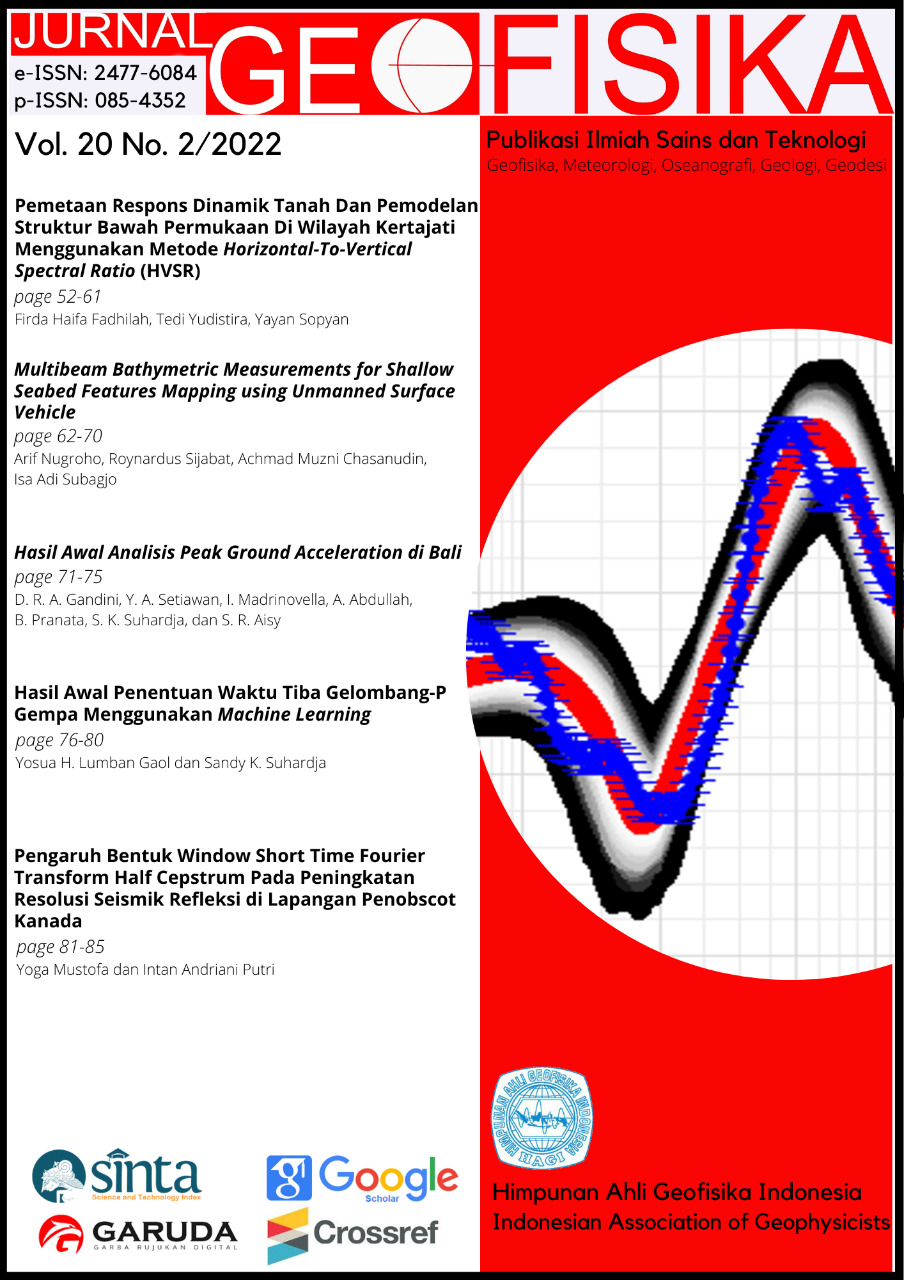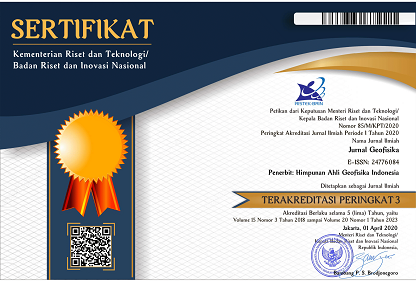Pemetaan Respons Dinamik Tanah Dan Pemodelan Struktur Bawah Permukaan Di Wilayah Kertajati Menggunakan Metode Horizontal-To-Vertical Spectral Ratio (HVSR)
Keywords
amplification, HVSR, predominant frequency, soil type, Vs30, VsAbstract
Abstrak
Wilayah Kertajati adalah wilayah yang didominasi oleh kondisi geologi berupa batuan lunak yaitu batuan sedimen Kuarter Bawah (Qos) yang mengalami pelapukan pada sebagian besar daerah penelitian dan adanya kenampakan Endapan Aluvium (Qa) pada sisi tenggara. Kondisi batuan lunak yang berada di atas batuan yang lebih keras akan mengakibatkan amplifikasi saat terjadinya gempa bumi. Hal ini dikarenakan pada barat daya daerah penelitian terdapat Sesar Baribis yang menunjam dari Purwakarta dan Majalengka. Sesar ini juga diperkirakan sempat mengakibatkan gempa paling besar yang pernah tercatat di Pulau jawa yang terjadi pada abad ke-17. Pada penelitian ini, pengolahan data mikrotremor dengan metode Horizontal to Vertical Spectral Ratio (HVSR) diharapkan dapat menjadi suatu upaya mitigasi bencana di wilayah Kertajati mengingat di wilayah tersebut juga telah dibangun Bandar Udara Internasional Jawa Barat (BIJB). HVSR adalah metode seismik yang dapat digunakan untuk mengidentifikasi karakteristik dinamik tanah berupa frekuensi dominan dan amplifikasi, serta dapat menghasilkan gambaran struktur seismik bawah permukaan. Dari hasil pengolahan data yang telah dilakukan diperoleh nilai frekuensi dominan bervariasi dengan rentang 0,6-18 Hz sedangkan nilai amplifikasi memiliki rentang 1,26-6,3. Frekuensi dominan bernilai rendah berada pada bagian tengah, barat, dan bagian tenggara dari daerah penelitian, hal ini mengindikasikan ketebalan lapisan sedimen yang relatif lebih besar. Sedangkan nilai amplifikasi bernilai tinggi dominan berada pada bagian tengah dan sisi utara dari daerah penelitian. Pada tahap selanjutnya, dilakukan inversi kurva HVSR menggunakan metode Neighbourhood Algorithm (NA) untuk mengetahui informasi nilai bawah permukaan yang kemudian diasosiasikan dengan karakteristik lapisan soil bawah permukaan. Diperoleh nilai berkisar antara 53-3027 m/s untuk rentang kedalaman hingga 610 m, dengan nilai relatif lebih rendah pada sisi tengah, tenggara, dan barat laut, daerah penelitian. Dilakukan juga pengelompokan jenis tanah dengan nilai rata-rata kecepatan gelombang hingga kedalaman 30 m yang menunjukkan jenis tanah wilayah Kertajati berupa tanah sedang (SD) dan tanah padat atau batuan lunak (SC).
Kata kunci: amplifikasi, frekuensi dominan, HVSR. jenis tanah, ,
Abstract
Kertajati area is an area dominated by geological features in the form of soft rocks, namely Lower Quaternary sedimentary rocks (Qos) which have weathered in most of the research area and the appearance of Alluvium Deposits (Qa) on the southeast side. The condition of soft rock that is on top of the harder rock will result in amplification during an earthquake. Because in the southwest of the study area there is the Baribis Fault that subducts from Purwakarta and Majalengka. In this study, microtremor data processing with the Horizontal to Vertical Spectral Ratio (HVSR) method is expected to be a disaster mitigation effort in the Kertajati area considering that the area has also been built West Java International Airport (BIJB). HVSR is a seismic method that can be used to identify dynamic characteristics of the soil in the form of dominant frequency and amplification, and can produce an image of the subsurface seismic structure. From the results of data processing that has been carried out, the dominant frequency values vary in the range of 0.6-18 Hz while the amplification values have a range of 1.26-6.3. The dominant low-value frequencies are on the southeast, southwest, and central part of the study area, indicating a relatively larger thickness of the sediment layer. While the high value amplification values are dominant on the north, southwest, and central parts of the study area. Then the inversion of the HVSR curve was carried out using the Neighborhood Algorithm method to find out the information on the subsurface value which was then associated with the characteristics of the subsurface layer. The values of ranged from 33-3027 m/s for a depth range of up to 610 m, with relatively lower values on the south, northwest, and central parts of the study area. Soil types were also grouped with an average value of wave velocity to a depth of 30 m which indicated the soil types in the Kertajati area were medium soil (SD) and solid soil or soft rock (SC).
Keywords: amplification, HVSR, predominant frequency, soil type, Vs30, Vs
References
Bemmelen, R. V. 1949. General geology of Indonesia and adjacent archipelagoes, Government Printing Office, The Hague Martinus Nijhoff, 1.
Brown, L. T., Diehl, J. G., dan Nigbor, R. L. 2000. A simplified procedure to measure average shear-wave velocity to a depth of 30 meters (VS30). In Proceedings. 12th World Conference on Earthquake Engineering.
Cipta, A., Cummins, P., Dettmer, J., Saygin, E., Irsyam, M., Rudyanto, A., dan Murjaya, J. 2018. Seismic velocity structure of the Jakarta Basin, Indonesia, using trans-dimensional Bayesian inversion of horizontal-to-vertical spectral ratios. Geophysical Journal International, 215(1), 431-449.
Cipta, A., Rudyanto, A., Afif, H., Robiana, R., Solikhin, A., Omang, A., & Hidayati, S. 2021. Unearthing the buried Palu–Koro Fault and the pattern of damage caused by the 2018 Sulawesi Earthquake using HVSR inversion. Geological Society, London, Special Publications, 501(1), 185-203.
Djuri, 1995. Peta Geologi Lembar Arjawinangun, Jawa, sekala 1:100.000. Ed. 2, Pusat Penelitian dan Pegembangan Geologi, Bandung.
Gosar, A. 2010. Site effects and soil-structure resonance study in the Kobarid basin (NW Slovenia) using microtremors, Natural Hazards & Earth System Sciences, 10(4).
Grandis.H. (2009): Pengantar Pemodelan Inversi Geofisika. Himpunan Ahli Geofisika Indonesia (HAGI)
Hasibuan, G. dan Sudarsono, U. 2009. Geologi Teknik Daerah Kertajati Kabupaten Majalengka, Jawa Barat. Buletin Geologi Tata Lingkungan (Bulletin of Environtmental Geology, 19(3), 125-134.
Humaida, H., Zaennudin, A., dan Sutaningsih, N. E. 2012. Semburan gas bercampur air di Desa Candi Pari, Kecamatan Porong, Kabupaten Sidoarjo, Jawa Timur. Jurnal Lingkungan dan Bencana Geologi, 3(1), 1-19.
Konno, K., dan Kataoka, S. 2000. New method for estimating the average s-wave velocity of the ground, Proceedings of the 6th International Conference on Seismic Zonation.
Koulali, A., McClusky, S., Susilo, S., Leonard, Y., Cummins, P., Tregoning, P., dan Wijanarto, A. B. 2017. The kinematics of crustal deformation in Java from GPS observations: Implications for fault slip partitioning. Earth and Planetary Science Letters, 458, 69-79.
Marjiyono,. 2012. Estimasi Karakteristik Dinamik Tanah dari Data Mikrotremor. Institut Teknologi Bandung. 39
Musson, R.M.W. 2012. A provisional catalogue of historical earthquakes in Indonesia. British Geological Survey.
Nakamura, Y. 1989. A method for dynamic characteristics estimation of subsurface using microtremor on the ground surface, Quarterly Report of Railway Technical Research Institute (RTRI), 30(1).
Nakamura, Y. 2008. On the H/V spectrum, Proceedings of the 14th World Conference on Earthquake Engineering (14WCEE).
Nguyen, N., Griffin, J., Cipta, A., & Cummins, P. R. 2015. Indonesia’s Historical earthquakes. Modelled sample for improving the National hazard Maps, Geoscience of Australia.
Okada, H. 2003. Geophysical Monograph Series, Society of Exploration Geophysicists. 12.
Rong, M., Fu, L. Y., Wang, Z., Li, X., Carpenter, N. S., Woolery, E. W., dan Lyu, Y. 2017. On the Amplitude Discrepancy of HVSR and Site Amplification from Strong‐Motion Observations On the Amplitude Discrepancy of HVSR and Site Amplification from Strong‐Motion Observations. Bulletin of the Seismological Society of America, 107(6), 2873-2884.
Sudarsono, U., dan Hasibuan, G. 2011. Karakteristik Geologi Teknik Tanah Residu Batuan Sedimen Kuarter Bawah Daerah Kertajati, Majalengka, Jawa Barat Engineering Geological Characteristics of the Residual Soil, Lower Quaternary Sediments in Kertajati Region, Majalengka, West Java. Jurnal Geologi Indonesia, 6(3), 177-189.
Toiba, Y., Sili, P. D., dan Maskur, M. 2016. Analisis Mikrotremor Kawasan Palu Barat Berdasarkan Metode Horizontal to Vertical Spectral Ratio (HVSR). Gravitasi, 15(1).
Uebayashi, H., 2003. Extrapolation of Irregular Subsurface Structures Using the Horizontal-to-Vertical Spectral Ratio of Long-Period Microtremors. Bull. Seism. Soc. 93(2)
Wathelet, M., Jongmans, D., & Ohrnberger, M. 2004. Surface‐wave inversion using a direct search algorithm and its application to ambient vibration measurements. Near surface geophysics, 2(4), 211-221.

This work is licensed under a Creative Commons Attribution 4.0 International License.
The copyright of all articles belongs to the authors. All other copyrights is held by the Journal











